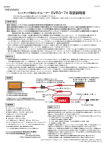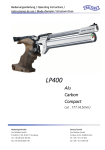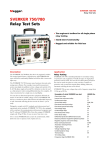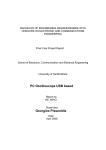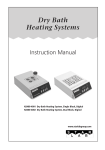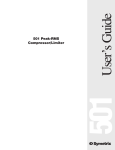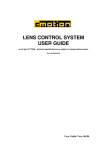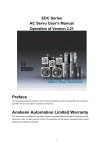Download OSD-232
Transcript
OSD-232 On-screen display character overlay board Version 1.02 Copyright © 1998 Intuitive Circuits, LLC D escription OSD-232 is a video on-screen character overlay board. From any RS-232 source like a personal computer or microcontroller like the Basic Stamp, display 28 columns by 11 rows of information (308 characters total) directly onto any NTSC or optional PAL baseband (video in) television or VCR. OSD-232 can overlay monochrome text onto an incoming video source or display colored text on a selfgenerated colored background screen (e.g. a blue screen). Text color, blinking, zoom level, cursor positioning, and the background color is controlled through the PC’s serial routines or the Stamp’s serout statement. Other commands include screen clearing, showing/hiding the text, and enabling/disabling translucent text, a feature that allows video to pass through the text like the major television networks do with their logos. Specifications Dimensions: Weight: Input voltage: Operating temperature: Text area: Character set: Character size: Video levels: Video impedance: RS-232 serial input: 2 1/2” x 2 1/2” x 1/2” 0.8 oz. 8.0 to 14.0 volts DC (60 ma max.) 0º C to +70º C 28 columns by 11 rows (308 characters) 128 characters 12 x 18 pixels 1 volt peak to peak nominal composite video input 75 ohm, output 75 ohm resistively terminated 2400 or 4800 baud, 8 data bits, 1 stop bit, inverted data 2 Installation The following is the list of OSD-232 circuit board pads and what to attach them to. Pad Attach To +12 VDC and GND +8 to +14 volt supply VIDEO IN and GND Incoming NTSC/PAL video source (not required) VIDEO OUT and GND Outgoing NTSC/PAL video source with overlaid text SERIAL IN Stamp IO pin, DB-9 pin 3, or DB-25 pin 2 SERIAL GND Stamp GND, DB-9 pin 5, or DB-25 pin 7 Board Mounting Details Mount the OSD-232 board into a shielded enclosure to protect it from RF. For each of the four mounting holes be sure to use two 4-40 nuts or one 1/4” spacer between the OSD-232 board and chassis to prevent the bottom of the OSD-232 board from shorting to the chassis. 4-40 Nut #4 Lock Washer Circuit Board Two 4-40 Nuts (or one spacer) #4 Lock Washer Chassis Drill 1/8" dia hole 4-40 x 1/2" Screw Baud Configuration The OSD-232 comes with the BAUD jumper installed (4800 baud). If 2400 baud is desired (for slower controllers like the Basic I stamp) then remove the jumper. It is important to note that the OSD-232 only looks at the jumper when power is first applied. If the jumper is added or removed while OSD-232 is powered then the power must be turned off and back on before the new baud rate will be recognized. 3 Communicating with OSD-232 Communicating with OSD-232 consists of either sending a displayable character value of 0 through 127 (see the character chart on page 14) or sending a special command flag followed by some parameters (see the chart on page 5). Below are some examples of how to communicate with OSD-232. Remember to remove the BAUD jumper if connecting to a Basic I Stamp. Sending Text Displaying text on OSD-232 is a simple process of sending the appropriate ASCII text. In addition, special characters for drawing graphics, foreign language, etc. are available (see the character chart on page 14 for a complete listing). QBASIC example Basic 2 Stamp example print #1,“Hello universe.”; serout 0, $40BC, [“Hello universe.”] Basic 1 Stamp example Basic 2 Stamp (SX) example serout 0, N2400, (“Hello universe.”) serout 0, 16884, [“Hello universe.”] Setting The Cursor Position This example displays “Hi” at column 1, row 11. QBASIC example Basic 2 Stamp example print #1, chr$(129); chr$(1); chr$(11); “Hi”; serout 0, $40BC, [129,1,11,“Hi”] Basic 1 Stamp example Basic 2 Stamp (SX) example serout 0, N2400, (129,1,11,“Hi”) serout 0, 16884, [129, 1, 1, 11, “Hi”] Clearing The Screen The clear screen command takes 10 milliseconds (ms) to complete so a delay is required before other commands or text should be sent. QBASIC example Basic 2 Stamp example print #1, chr$(130); sleep 1 serout 0, $40BC, [130] pause 10 Basic 1 Stamp example Basic 2 Stamp (SX) example serout 0, N2400, (130) pause 10 serout 0, 16884, [130] pause 10 4 Below is the chart of the special commands. All values are decimal values not ASCII. Typing 130 from your favorite terminal program will not clear the screen. You just sent three ASCII values: 49 51 48. Also note if the reposition column is YES for a specific command then a position command (129) must follow before sending more text. Command Value Parameters Reposition Description MODE 128 1 YES Set the screen mode 0 = overlay (mixed with incoming video) 1 = full screen (OSD-232 generated background) POSITION 129 2 NO Set the cursor position x (1-28), y (1-11) CLEAR SCREEN 130 0 VISIBLE 131 1 YES Show or hide text 0 = hide text 1 = show text TRANSLUCENT 132 1 YES Set translucent text (overlay mode) 0 = off 1 = on BACKGROUND COLOR 133 1 YES Set background color (full screen mode) 0 = black, 1 = blue, 2 = green, 3 = cyan, 4 = red, 5 = magenta, 6 = yellow, 7 = white ZOOM 134 3 YES Set character row zoom level row (1-11), horizontal zoom (1-4), vertical zoom (1-4) Note: zoom settings for any row 2 - 10 effect all 9 of them. CHARACTER COLOR 135 1 NO Set character color (full screen mode) 0 = black, 1 = blue, 2 = green, 3 = cyan, 4 = red, 5 = magenta, 6 = yellow, 7 = white CHARACTER BLINK 136 1 NO Set character blink 0 = off 1 = on RESET 137 0 SET VERTICAL OFFSET 138 1 YES Set the text screen vertical position offset (1-63) SET HORIZONTAL 139 OFFSET 1 YES Set the text screen horizontal position offset (1-58) set to 1,1 Clear the entire screen with spaces (wait 10 ms after command sent) set to 1,1 Reset OSD-232 to default (power-up) settings (wait 10 ms after command sent) 5 Listing 1 - QBASIC Sample ‘ QBSAMPLE.BAS ‘ ‘ A sample program to exercise OSD-232 via a QBASIC on the P.C. ‘ The current time is displayed on a black screen with white numbers. ‘ Remember to install the “BAUD” jumper for 4800 baud operation and ‘ change cport$ below for the proper com port. ‘ ‘ (c) Copyright 1998 Intuitive Circuits, LLC. ‘ cport$ = “2” ‘ com port 2 ‘ ——-[constants]—————————————————————————————‘ colors cBLACK$ = CHR$(0) cBLUE$ = CHR$(1) cGREEN$ = CHR$(2) cCYAN$ = CHR$(3) cRED$ = CHR$(4) cMAGENTA$ = CHR$(5) cYELLOW$ = CHR$(6) cWHITE$ = CHR$(7) ‘ commands cMODE$ = CHR$(128) ‘ overlay or full screen (one parameter) ‘ overlay mode (0), full screen (1) cSETPOS$ = CHR$(129) ‘ set cursor position (2 parameters) ‘ x (1-28), y (1-11) cCLS$ = CHR$(130) ‘ clear the screen (no parameters) ‘ user must wait 10 ms cTEXTVIS$ = CHR$(131) ‘ text visibility (one parameter) ‘ hide (0), show (1) cTRANSLUCENT$ = CHR$(132) ’ translucent text (one parameter) ‘ off (0), on (1) cBACKCOLOR$ = CHR$(133) ‘ background color (one parameter) ‘ color (0-7) ‘ zoom (three parameters) cZOOM$ = CHR$(134) ‘ row (1-11) hscale(1-4) vscale(1-4) 6 cCHARCOLOR$ = CHR$(135) cCHARBLINK$ = CHR$(136) cRESET$ = CHR$(137) cSETVOFFSET$ = CHR$(138) cSETHOFFSET$ = CHR$(139) ‘ character color (one parameter) ‘ color (0 - 7) ‘ character blink (one parameter) ‘ off (0), on (1) ‘ reset osd-232 ‘ user must wait 10 ms ‘ set the text screen vertical position (one parameter) ‘ offset (1-63) ‘ set the text screen horizontal position (one parameter) ‘ offset (1-58) ‘ ——-[program entry]———————————————————————————‘ open com port with all handshaking disabled settings$ = “com” + cport$ + “:4800,n,8,1,CD0,CS0,DS0,OP0” OPEN settings$ FOR RANDOM AS #1 PRINT #1, cRESET$; SLEEP 1 ‘ reset osd-232 and clear the screen ‘ wait 10 ms PRINT #1, cMODE$; CHR$(1); PRINT #1, cBACKCOLOR$; cBLACK$; ‘ make full screen ‘ set screen color to black PRINT #1, cCHARCOLOR$; cWHITE$; ‘ text is white PRINT #1, cSETPOS$; CHR$(3); CHR$(5); ‘ set cursor at xpos 1, ypos 5 PRINT #1, “Current Time:”; ENDLESS: PRINT #1, cSETPOS$; CHR$(18); CHR$(5);‘ set cursor at xpos 16, ypos 5 PRINT #1, TIME$; SLEEP 1 GOTO ENDLESS CLOSE ‘ close the com port (will never get here) END 7 Listing 2 - Basic Stamp I (BS1) Sample ‘ SAMPLE.BAS ‘ ‘ A sample program to exercise OSD-232 via a Parallax Basic I Stamp. ‘ Remember the “BAUD” jumper must be removed (2400 baud). ‘ ‘ (C) Copyright 1998, Intuitive Circuits, LLC ‘ ‘ Connect OSD-232 to the Basic Stamp I as follows: ‘ ‘ Stamp I (GND) -> OSD-232 (SERIAL GND) ‘ Stamp I (I/O 0) -> OSD-232 (SERIAL IN) ‘ ‘ ——-[color constants]———————————————————————————symbol cBLACK = 0 symbol cBLUE = 1 symbol cGREEN = 2 symbol cCYAN = 3 symbol cRED = 4 symbol cMAGENTA = 5 symbol cYELLOW = 6 symbol cWHITE = 7 ‘ ——-[command constants]—————————————————————————symbol cMODE = 128 ‘ overlay or full screen (one parameter) ‘ overlay mode (0), full screen (1) symbol cSETPOS = 129 ‘ set cursor position (2 parameters) ‘ x (1-28), y (1-11) symbol cCLS = 130 ‘ clear the screen (no parameters) ‘ user must wait 10 ms symbol cTEXTVIS = 131 ‘ text visibility (one parameter) ‘ hide (0), show (1) symbol cTRANSLU = 132 ‘ translucent text (one parameter) ‘ off (0), on (1) symbol cBACKCOLOR = 133 ‘ background color (one parameter) ‘ color (0-7) symbol cZOOM = 134 ‘ zoom (three parameters) ‘ row (1-11) hscale(1-4) vscale(1-4) symbol cCHARCOLOR = 135 ‘ character color (one parameter) ‘ color (0 - 7) symbol cCHARBLINK = 136 ‘ character blink (one parameter) ‘ off (0), on (1) 8 symbol cRESET = 137 ‘ reset osd-232 ‘ user must wait 10 ms symbol cSETVOFFSET = 138 ‘ set the text screen vertical position (one parameter) ‘ offset (1-63) symbol cSETHOFFSET = 139 ‘ set the text screen horizontal position (one parameter) ‘ offset (1-58) ‘ ——-[variables]——————————————————————————————symbol cnt = w0 ‘ counter main: pause 500 ‘ wait for OSD-232 to power-up serout 0,N2400,(cMODE,1) ‘ make full screen serout 0,N2400,(cBACKCOLOR,cBLACK) ‘ set screen color to black serout 0,N2400,(cTEXTVIS,0) ‘ hide text while drawing a full screen serout 0,N2400,(cCLS) ‘ clear the screen pause 10 ‘ wait 10 ms serout 0,N2400,(cCHARCOLOR,cRED) serout 0,N2400,(“Character Set:”) serout 0,N2400,(cCHARCOLOR,cWHITE) serout 0,N2400,(cSETPOS,1,2) ‘ set cursor at xpos 1 and ypos 2 ‘ draw character set for cnt = 0 TO 127 serout 0,N2400,(cnt) next serout 0,N2400,(cCHARCOLOR,cGREEN) serout 0,N2400,(cCHARBLINK,1) serout 0,N2400,(cSETPOS,1,11) serout 0,N2400,(“Blinking green text.”) serout 0,N2400,(cCHARBLINK,0) serout 0,N2400,(cSETPOS,28,11) serout 0,N2400,(95) ‘ draw icon serout 0,N2400,(cTEXTVIS,1) ‘ show text end 9 Listing 3 - Basic Stamp II (BS2) Sample ‘ SAMPLE.BS2 ‘ ‘ A sample program to exercise OSD-232 via a Parallax Basic II Stamp. ‘ ‘ (C) Copyright 1998, Intuitive Circuits, LLC ‘ ‘ Connect OSD-232 to the Basic Stamp II as follows: ‘ Remember if the “BAUD” jumper is removed then ‘ change all the serout statements cN48 parameter (4800 baud) to cN24 (2400 baud) ‘ ‘ Stamp II pin 4 (GND) -> OSD-232 (SERIAL GND) ‘ Stamp II pin 5 (I/O 0) -> OSD-232 (SERIAL IN) ‘ DIRS = %0000000000000001 ‘ Input pins are 0, output pins are 1, and pin 0 is ‘ the right most bit. So make pin 0 an output. ‘ ——-[pin constants]————————————————————————————cSEROUT CON 0 ‘ pin 0 - serial out to OSD-232 ‘ ——-[misc constants]———————————————————————————— cN48 CON $4000+188 ‘ 4800 baud, 8 bit, no parity, inverted data cN24 CON $4000+396 ‘ 2400 baud, 8 bit, no parity, inverted data ‘ ——-[color constants]———————————————————————————cBLACK CON 0 cBLUE CON 1 cGREEN CON 2 cCYAN CON 3 cRED CON 4 cMAGENTA CON 5 cYELLOW CON 6 cWHITE CON 7 ‘ ——-[command constants]—————————————————————————— cMODE CON 128 ‘ overlay or full screen (one parameter) ‘ overlay mode (0), full screen (1) cSETPOS CON 129 ‘ set cursor position (2 parameters) ‘ x (1-28), y (1-11) cCLS CON 130 ‘ clear the screen (no parameters) ‘ user must wait 10 ms cTEXTVIS CON 131 ‘ text visibility (one parameter) ‘ hide (0), show (1) CON 132 ‘ translucent text (one parameter) cTRANSLU ‘ off (0), on (1) 10 cBACKCOLOR CON 133 cZOOM CON 134 cCHARCOLOR CON 135 cCHARBLINK CON 136 cRESET CON 137 cSETVOFFSET CON 138 cSETHOFFSET CON 139 ‘ background color (one parameter) ‘ color (0-7) ‘ zoom (three parameters) ‘ row (1-11) hscale(1-4) vscale(1-4) character color (one parameter) ‘ color (0 - 7) ‘ character blink (one parameter) ‘ off (0), on (1) ‘ reset osd-232 ‘ user must wait 10 ms ‘ set the text screen vertical position (one parameter) ‘ offset (1-63) ‘ set the text screen horizontal position (one parameter) ‘ offset (1-58) ‘ ——-[variables]——————————————————————————————cnt VAR BYTE ‘ counter main: pause 500 ‘ wait for OSD-232 to power-up serout cSEROUT,cN48,[cMODE,1] ‘ make full screen serout cSEROUT,cN48,[cBACKCOLOR,cBLACK] ‘ set screen color to black serout cSEROUT,cN48,[cTEXTVIS,0] ‘ hide text while drawing a full screen serout cSEROUT,cN48,[cCLS] ‘ clear the screen pause 10 ‘ wait 10 ms serout cSEROUT,cN48,[cCHARCOLOR,cRED] serout cSEROUT,cN48,[“Character Set:”] serout cSEROUT,cN48,[cCHARCOLOR,cWHITE] serout cSEROUT,cN48,[cSETPOS,1,2] ‘ set cursor at xpos 1 and ypos 2 ‘ draw character set for cnt = 0 TO 127 serout cSEROUT,cN48,[cnt] next serout cSEROUT,cN48,[cCHARCOLOR,cGREEN] serout cSEROUT,cN48,[cCHARBLINK,1] serout cSEROUT,cN48,[cSETPOS,1,11] serout cSEROUT,cN48,[“Blinking green text.”] serout cSEROUT,cN48,[cCHARBLINK,0] serout cSEROUT,cN48,[cSETPOS,28,11] serout cSEROUT,cN48,[95] ‘ draw icon serout cSEROUT,cN48,[cTEXTVIS,1] ‘ show text end 11 Listing 4 - Basic Stamp II (BSX) Sample ‘ SAMPLE.BSX ‘ ‘ A sample program to exercise OSD-232 via a Parallax Basic II SX Stamp. ‘ Remember if the “BAUD” jumper is removed then change all the serout ‘ statements cN48 parameter (4800 baud) to cN24 (2400 baud). ‘ ‘ (C) Copyright 1998, Intuitive Circuits, LLC ‘ ‘ Connect OSD-232 to the Basic Stamp II SX as follows: ‘ ‘ Stamp II SX pin 4 (GND) -> OSD-232 (SERIAL GND) ‘ Stamp II SX pin 5 (I/O 0) -> OSD-232 (SERIAL IN) ‘ DIRS = %0000000000000001 ‘ Input pins are 0, output pins are 1, and pin 0 is ‘ the right most bit. So make pin 0 an output. ‘ ——-[pin constants]————————————————————————————cSEROUT CON 0 ‘ pin 0 - serial out to OSD-232 ‘ ——-[misc constants]———————————————————————————— cN48 CON 16884 ‘ 4800 baud, 8 bit, no parity, inverted data cN24 CON 17405 ‘ 2400 baud, 8 bit, no parity, inverted data ‘ ——-[color constants]———————————————————————————cBLACK CON 0 cBLUE CON 1 cGREEN CON 2 cCYAN CON 3 cRED CON 4 cMAGENTA CON 5 cYELLOW CON 6 cWHITE CON 7 ‘ ——-[command constants]—————————————————————————cMODE CON 128 ‘ overlay or full screen (one parameter) ‘ overlay mode (0), full screen (1) cSETPOS CON 129 ‘ set cursor position (2 parameters) ‘ x (1-28), y (1-11) cCLS CON 130 ‘ clear the screen (no parameters) ‘ user must wait 10 ms cTEXTVIS CON 131 ‘ text visibility (one parameter) ‘ hide (0), show (1) CON 132 ‘ translucent text (one parameter) cTRANSLU ‘ off (0), on (1) 12 cBACKCOLOR CON 133 cZOOM CON 134 cCHARCOLOR CON 135 cCHARBLINK CON 136 cRESET CON 137 cSETVOFFSET CON 138 cSETHOFFSET CON 139 ‘ background color (one parameter) ‘ color (0-7) ‘ zoom (three parameters) ‘ row (1-11) hscale(1-4) vscale(1-4) ‘ character color (one parameter) ‘ color (0 - 7) ‘ character blink (one parameter) ‘ off (0), on (1) ‘ reset osd-232 ‘ user must wait 10 ms ‘ set the text screen vertical position (one parameter) ‘ offset (1-63) ‘ set the text screen horizontal position (one parameter) ‘ offset (1-58) ‘ ——-[variables]——————————————————————————————cnt VAR BYTE ‘ counter main: pause 500 ‘ wait for OSD-232 to power-up serout cSEROUT,cN48,[cMODE,1] ‘ make full screen serout cSEROUT,cN48,[cBACKCOLOR,cBLACK] ‘ set screen color to black serout cSEROUT,cN48,[cTEXTVIS,0] ‘ hide text while drawing a full screen serout cSEROUT,cN48,[cCLS] ‘ clear the screen pause 10 ‘ wait 10 ms serout cSEROUT,cN48,[cCHARCOLOR,cRED] serout cSEROUT,cN48,[“Character Set:”] serout cSEROUT,cN48,[cCHARCOLOR,cWHITE] serout cSEROUT,cN48,[cSETPOS,1,2] ‘ set cursor at xpos 1 and ypos 2 ‘ draw character set for cnt = 0 TO 127 serout cSEROUT,cN48,[cnt] next serout cSEROUT,cN48,[cCHARCOLOR,cGREEN] serout cSEROUT,cN48,[cCHARBLINK,1] serout cSEROUT,cN48,[cSETPOS,1,11] serout cSEROUT,cN48,[“Blinking green text.”] serout cSEROUT,cN48,[cCHARBLINK,0] serout cSEROUT,cN48,[cSETPOS,28,11] serout cSEROUT,cN48,[95] ‘ draw icon serout cSEROUT,cN48,[cTEXTVIS,1] ‘ show text end 13 Character Chart Below is the chart of the 128 displayable on-screen characters. Each character is 12 x 18 pixels. To determine the value of a particular character add the column number to the row number. For example the key symbol is column number 48 + row number 14 = 62. 0 16 32 48 64 80 96 112 0 1 2 3 4 5 6 7 8 9 10 11 12 13 14 15 14 Trouble Shooting Tips Problem Solution Green LED off (won’t power up) • Check power supply output (8 to 14 VDC). • Check polarity of supply to OSD-232 board. Screen is unreadable • If overlay mode then check that the OSD-232 “VIDEO IN” has a valid video signal. Garbage characters on screen or text not displayed • Verify communication: 4800 baud (jumper installed) 2400 baud (jumper removed) • Last command sent (see page 5) might require cursor to be repositioned. • Verify common ground shared between Stamp and OSD-232. Warranty & Service If the product fails to perform as described in our product description or specification, within 90 days from the date of shipment to the buyer, we will repair or replace the product and/or accessories originally supplied. Failure due to improper installation, misuse, abuse or accident is not covered by this warranty. Incidental and consequential damages are not covered by this warranty. The buyer must obtain a Return Material Authorization by calling (248) 524-1918, and shipping the defective product to Intuitive Circuits, 2275 Brinston, Troy, MI 48083, freight prepaid. 15 Intuitive Circuits, LLC 2275 Brinston Troy, MI 48083 Voice: (248) 524-1918 Fax: (248) 524-3808 http://www.icircuits.com
















